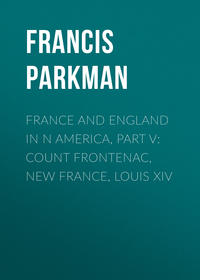 полная версия
полная версияFrance and England in N. America, Part III: The Discovery of the Great West
A feast of four courses now followed. First, a wooden bowl full of a porridge of Indian meal boiled with grease was set before the guests, and the master of ceremonies fed them in turn, like infants, with a large spoon. Then, appeared a platter of fish; and the same functionary, carefully removing the bones with his fingers, and blowing on the morsels to cool them, placed them in the mouths of the two Frenchmen. A large dog, killed and cooked for the occasion, was next placed before them; but, failing to tempt their fastidious appetites, was supplanted by a dish of fat buffalo-meat, which concluded the entertainment. The crowd having dispersed, buffalo-robes were spread on the ground, and Marquette and Joliet spent the night on the scene of the late festivity. In the morning, the chief, with some six hundred of his tribesmen, escorted them to their canoes, and bade them, after their stolid fashion, a friendly farewell.
Again they were on their way, slowly drifting down the great river. They passed the mouth of the Illinois, and glided beneath that line of rocks on the eastern side, cut into fantastic forms by the elements, and marked as "The Ruined Castles" on some of the early French maps. Presently they beheld a sight which reminded them that the Devil was still lord paramount of this wilderness. On the flat face of a high rock, were painted in red, black, and green a pair of monsters,—each "as large as a calf, with horns like a deer, red eyes, a beard like a tiger, and a frightful expression of countenance. The face is something like that of a man, the body covered with scales; and the tail so long that it passes entirely round the body, over the head and between the legs, ending like that of a fish." Such is the account which the worthy Jesuit gives of these manitous, or Indian gods. [Footnote: The rock where these figures were painted is immediately above the city of Alton. The tradition of their existence remains, though they are entirely effaced by time. In 1867, when I passed the place, a part of the rock had been quarried away, and, instead of Marquette's monsters, it bore a huge advertisement of "Plantation Bitters." Some years ago, certain persons, with more zeal than knowledge, proposed to restore the figures, after conceptions of their own; but the idea was abandoned.
Marquette made a drawing of the two monsters, but it is lost. I have, however, a fac-simile of a map made a few years later by order of the Intendant Duchesneau; which is decorated with the portrait of one of them, answering to Marquette's description, and probably copied from his drawing. St. Cosme, who saw them in 1699, says that they were even then almost effaced. Douay and Joutel also speak of them; the former, bitterly hostile to his Jesuit contemporaries, charging Marquette with exaggeration in his account of them. Joutel could see nothing terrifying in their appearance; but he says that his Indians made sacrifices to them as they passed.] He confesses that at first they frightened him; and his imagination and that of his credulous companions were so wrought upon by these unhallowed efforts of Indian art, that they continued for a long time to talk of them as they plied their paddles. They were thus engaged, when they were suddenly aroused by a real danger. A torrent of yellow mud rushed furiously athwart the calm blue current of the Mississippi; boiling and surging, and sweeping in its course logs, branches, and uprooted trees. They had reached the mouth of the Missouri, where that savage river, descending from its mad career through a vast unknown of barbarism, poured its turbid floods into the bosom of its gentler sister. Their light canoes whirled on the miry vortex like dry leaves on an angry brook. "I never," writes Marquette, "saw any thing more terrific;" but they escaped with their fright, and held their way down the turbulent and swollen current of the now united rivers. [Footnote: The Missouri is called Pekitanouï by Marquette. It also bears, on early French maps, the names of Rivière des Osages, and Rivière des Emissourites, or Oumessourits. On Marquette's map, a tribe of this name is placed near its banks, just above the Osages. Judging by the course of the Mississippi that it discharged into the Gulf of Mexico, he conceived the hope of one day reaching the South Sea by way of the Missouri.] They passed the lonely forest that covered the site of the destined city of St. Louis, and, a few days later, saw on their left the mouth of the stream to which the Iroquois had given the well-merited name of Ohio, or, the Beautiful River. [Footnote: Called on Marquette's map, Ouabouskiaou. On some of the earliest maps, it is called Ouabache (Wabash).] Soon they began to see the marshy shores buried in a dense growth of the cane, with its tall straight stems and feathery light-green foliage. The sun glowed through the hazy air with a languid stifling heat, and, by day and night, mosquitoes in myriads left them no peace. They floated slowly down the current, crouched in the shade of the sails which they had spread as awnings, when suddenly they saw Indians on the east bank. The surprise was mutual, and each party was as much frightened as the other. Marquette hastened to display the calumet which the Illinois had given him by way of passport; and the Indians, recognizing the pacific symbol, replied with an invitation to land. Evidently, they were in communication with Europeans, for they were armed with guns, knives, and hatchets, wore garments of cloth, and carried their gunpowder in small bottles of thick glass. They feasted the Frenchmen with buffalo-meat, bear's oil, and white plums; and gave them a variety of doubtful information, including the agreeable but delusive assurance that they would reach the mouth of the river in ten days. It was, in fact, more than a thousand miles distant.
They resumed their course, and again floated down the interminable monotony of river, marsh and forest. Day after day passed on in solitude, and they had paddled some three hundred miles since their meeting with the Indians; when, as they neared the mouth of the Arkansas, they saw a cluster of wigwams on the west bank. Their inmates were all astir, yelling the war-whoop, snatching their weapons, and running to the shore to meet the strangers, who, on their part, called for succor to the Virgin. In truth they had need of her aid; for several large wooden canoes, filled with savages, were putting out from the shore, above and below them, to cut off their retreat, while a swarm of headlong young warriors waded into the water to attack them. The current proved too strong; and, failing to reach the canoes of the Frenchmen, one of them threw his war-club, which flew over the heads of the startled travellers. Meanwhile, Marquette had not ceased to hold up his calumet, to which the excited crowd gave no heed, but strung their bows and notched their arrows for immediate action; when at length the elders of the village arrived, saw the peace-pipe, restrained the ardor of the youth, and urged the Frenchmen to come ashore. Marquette and his companions complied, trembling, and found a better reception than they had reason to expect. One of the Indians spoke a little Illinois, and served as interpreter; a friendly conference was followed by a feast of sagamite and fish; and the travellers, not without sore misgivings, spent the night in the lodges of their entertainers. [Footnote: This village, called Mitchigamea, is represented on several contemporary maps.]
Early in the morning, they embarked again, and proceeded to a village of the Arkansas tribe, about eight leagues below. Notice of their coming was sent before them by their late hosts; and, as they drew near, they were met by a canoe, in the prow of which stood a naked personage, holding a calumet, singing, and making gestures of friendship. On reaching the village, which was on the east side, [Footnote: A few years later, the Arkansas were all on the west side.] opposite the mouth of the river Arkansas, they were conducted to a sort of scaffold before the lodge of the war-chief. The space beneath had been prepared for their reception, the ground being neatly covered with rush mats. On these they were seated; the warriors sat around them in a semi-circle; then the elders of the tribe; and then the promiscuous crowd of villagers, standing, and staring over the heads of the more dignified members of the assembly. All the men were naked; but, to compensate for the lack of clothing, they wore strings of beads in their noses and ears. The women were clothed in shabby skins, and wore their hair clumped in a mass behind each ear. By good luck, there was a young Indian in the village, who had an excellent knowledge of Illinois; and through him Marquette endeavored to explain the mysteries of Christianity, and to gain information concerning the river below. To this end he gave his auditors the presents indispensable on such occasions, but received very little in return. They told him that the Mississippi was infested by hostile Indians, armed with guns procured from white men; and that they, the Arkansas, stood in such fear of them that they dared not hunt the buffalo, but were forced to live on Indian corn, of which they raised three crops a year.
During the speeches on either side, food was brought in without ceasing; sometimes a platter of sagamite or mush; sometimes of corn boiled whole; sometimes a roasted dog. The villagers had large earthen pots and platters, made by themselves with tolerable skill,—as well as hatchets, knives, and beads, gained by traffic with the Illinois and other tribes in contact with the French or Spaniards. All day there was feasting without respite, after the merciless practice of Indian hospitality; but at night some of their entertainers proposed to kill and plunder them,—a scheme which was defeated by the vigilance of the chief, who visited their quarters, and danced the calumet dance to reassure his guests.
The travellers now held counsel as to what course they should take. They had gone far enough, as they thought, to establish one important point,– that the Mississippi discharged its waters, not into the Atlantic or sea of Virginia, nor into the Gulf of California or Vermilion Sea, but into the Gulf of Mexico. They thought themselves nearer to its mouth than they actually were,—the distance being still about seven hundred miles; and they feared that, if they went farther, they might be killed by Indians or captured by Spaniards, whereby the results of their discovery would be lost. Therefore they resolved to return to Canada, and report what they had seen.
They left the Arkansas village, and began their homeward voyage on the seventeenth of July. It was no easy task to urge their way upward, in the heat of midsummer, against the current of the dark and gloomy stream, toiling all day under the parching sun, and sleeping at night in the exhalations of the unwholesome shore, or in the narrow confines of their birchen vessels, anchored on the river. Marquette was attacked with dysentery. Languid and well-nigh spent, he invoked his celestial mistress. as day after day, and week after week, they won their slow way northward. At length they reached the Illinois, and, entering its mouth, followed its course, charmed, as they went, with its placid waters, its shady forests, and its rich plains, grazed by the bison and the deer. They stopped at a spot soon to be made famous in the annals of western discovery. This was a village of the Illinois, then called Kaskaskia,—a name afterwards transferred to another locality. [Footnote: Marquette says that it consisted at this time of seventy-four lodges. These, like the Huron and Iroquois lodges, contained each several fires and several families. This village was about seven miles below the site of the present town of Ottawa.] A chief, with a band of young warriors, offered to guide them to the Lake of the Illinois; that is to say, Lake Michigan. Thither they repaired; and, coasting its shores, reached Green Bay at the end of September, after an absence of about four months, during which they had paddled their canoes somewhat more than two thousand five hundred miles. [Footnote: The journal of Marquette, first published in an imperfect form by Thevenot, in 1681, has been reprinted by Mr. Lenox, under the direction of Mr. Shea, from the manuscript preserved in the archives of the Canadian Jesuits. It will also be found in Shea's Discovery and Exploration of the Mississippi Valley, and the Relations Inédites, of Martin. The true map of Marquette accompanies all these publications. The map published by Thevenot and reproduced by Bancroft is not Marquette's.
The original of this, of which I have a fac-simile, bears the title Carte de la Nouvelle Découverte que les Pères Jésuites out fait en l'année 1672, et continuée par le Père Jacques Marquette, etc. The return route of the expedition is incorrectly laid down on it. A manuscript map of the Jesuit Raffeix, preserved in the Bibliothèque Impériale, is more accurate in this particular. I have also another contemporary manuscript map, indicating the various Jesuit stations in the west at this time, and representing the Mississippi, as discovered by Marquette. For these and other maps, see Appendix.]
Marquette remained, to recruit his exhausted strength; but Joliet descended to Quebec, to bear the report of his discovery to Count Frontenac. Fortune had wonderfully favored him on his long and perilous journey; but now she abandoned him on the very threshold of home. At the foot of the rapids of La Chine, and immediately above Montreal, his canoe was overset, two of his men and an Indian boy were drowned, all his papers were lost, and he himself narrowly escaped. [Footnote: Lettre de Frontenac au Ministre, Québec, 14 Nov. 1674, MS.] In a letter to Frontenac, he speaks of the accident as follows: "I had escaped every peril from the Indians; I had passed forty-two rapids; and was on the point of disembarking, full of joy at the success of so long and difficult an enterprise,—when my canoe capsized, after all the danger seemed over. I lost two men, and my box of papers, within sight of the first French settlements, which I had left almost two years before. Nothing remains to me but my life, and the ardent desire to employ it on any service which you may please to direct." [Footnote: This letter is appended to Joliet's smaller map of his discoveries. See Appendix. Joliet applied for a grant of the countries he had visited, but failed to obtain it, because the king wished at this time to confine the inhabitants of Canada to productive industry within the limits of the colony, and to restrain their tendency to roam into the western wilderness. On the seventh of October, 1675, Joliet married Claire Bissot, daughter of a wealthy Canadian merchant, engaged in trade with the northern Indians. This drew Joliet's attention to Hudson's Bay, and he made a journey thither in 1679, by way of the Saguenay. He found three English forts on the bay, occupied by about sixty men, who had also an armed vessel of twelve guns and several small trading-craft. The English held out great inducements to Joliet to join them; but he declined, and returned to Quebec, where he reported that, unless these formidable rivals were dispossessed, the trade of Canada would be ruined. In consequence of this report, some of the principal merchants of the colony formed a company to compete with the English in the trade of Hudson's Bay. In the year of this journey, Joliet received a grant of the islands of Mignan; and in the following year, 1680, he received another grant, of the great island of Anticosti in the lower St. Lawrence. In 1681, he was established here with his wife and six servants. He was engaged in fisheries; and, being a skilful navigator and surveyor, he made about this time a chart of the St. Lawrence. In 1690, Sir William Phips, on his way with an English fleet to attack Quebec, made a descent on Joliet's establishment, burnt his buildings, and took prisoners his wife and his mother-in-law. In 1694, Joliet explored the coasts of Labrador under the auspices of a company formed for the whale and seal fishery. On his return, Frontenac made him royal pilot for the St. Lawrence; and at about the same time he received the appointment of hydrographer at Quebec. He died, apparently poor, in 1699 or 1700, and was buried on one of the islands of Mignan. The discovery of the above facts is due in great part to the researches of Margry.]
Marquette spent the winter and the following summer at the mission of Green Bay, still suffering from his malady. In the autumn, however, it abated, and he was permitted by his superior to attempt the execution of a plan to which he was devotedly attached,—the founding, at the principal town of the Illinois, of a mission to be called the Immaculate Conception, a name which he had already given to the river Mississippi; He set out on this errand on the twenty-fifth of October, accompanied by two men, named Pierre and Jacques, one of whom had been with him on his great journey of discovery. A band of Pottawattamies and another band of Illinois also joined him. The united parties—ten canoes in all—followed the east shore of Green Bay as far as the inlet then called Sturgeon Cove, from the head of which they crossed by a difficult portage through the forest to the shore of Lake Michigan. November had come. The bright hues of the autumn foliage were changed to rusty brown. The shore was desolate, and the lake was stormy. They were more than a month in coasting its western border, when at length they reached the river Chicago, entered it, and ascended about two leagues. Marquette's disease had lately returned, and hemorrhage now ensued. He told his two companions that this journey would be his last. In the condition in which he was, it was impossible to go farther. The two men built a log-hut by the river, and here they prepared to spend the winter, while Marquette, feeble as he was, began the spiritual exercises of Saint Ignatius, and confessed his two companions twice a week.
Meadow, marsh, and forest were sheeted with snow, but game was abundant. Pierre and Jacques killed buffalo and deer and shot wild turkeys close to their hut. There was an encampment of Illinois within two days' journey; and other Indians, passing by this well known thoroughfare, occasionally visited them, treating the exiles kindly, and sometimes bringing them game and Indian corn. Eighteen leagues distant was the camp of two adventurous French traders,—one of them a noted coureur de bois, nicknamed La Taupine, [Footnote: Pierre Moreau, alias La Taupine, was afterwards bitterly complained of by the Intendant Duchesneau for acting as the Governor's agent in illicit trade with the Indians.] and the other a self- styled surgeon. They also visited Marquette, and befriended him to the best of their power.
Urged by a burning desire to lay, before he died, the foundation of his new mission of the Immaculate Conception, Marquette begged his two followers to join him in a novena, or nine days' devotion to the Virgin. In consequence of this, as he believed, his disease relented; he began to regain strength, and, in March, was able to resume the journey. On the thirtieth of the month, they left their hut, which had been inundated by a sudden rise of the river, and carried their canoe through mud and water over the portage which led to the head of the Des Plaines. Marquette knew the way, for he had passed by this route on his return from the Mississippi. Amid the rains of opening spring, they floated down the swollen current of the Des Plaines, by naked woods, and spongy, saturated prairies, till they reached its junction with the main stream of the Illinois, which they descended to their destination,—the Indian town which Marquette calls Kaskaskia. Here, as we are told, he was received "like an angel from Heaven." He passed from wigwam to wigwam, telling the listening crowds of God and the Virgin, Paradise and Hell, angels and demons; and, when he thought their minds prepared, he summoned them all to a grand council.
It took place near the town, on the great meadow which lies between the river and the modern village of Utica. Here five hundred chiefs and old men were seated in a ring; behind stood fifteen hundred youths and warriors, and behind these again all the women and children of the village. Marquette, standing in the midst, displayed four large pictures of the Virgin; harangued the assembly on the mysteries of the Faith, and exhorted them to adopt it. The temper of his auditory met his utmost wishes. They begged him to stay among them and continue his instructions; but his life was fast ebbing away, and it behooved him to depart.
A few days after Easter he left the village, escorted by a crowd of Indians, who followed him as far as Lake Michigan. Here he embarked with his two companions. Their destination was Michillimackinac, and their course lay along the eastern borders of the lake. As, in the freshness of advancing spring, Pierre and Jacques urged their canoe along that lonely and savage shore, the priest lay with dimmed sight and prostrated strength, communing with the Virgin, and the angels. On the nineteenth of May he felt that his hour was near; and, as they passed the mouth of a small river, he requested his companions to land. They complied, built a shed of bark on a rising ground near the bank, and carried thither the dying Jesuit. With perfect cheerfulness and composure he gave directions for his burial, asked their forgiveness for the trouble he had caused them, administered to them the sacrament of penitence, and thanked God that he was permitted to die in the wilderness, a missionary of the faith and a member of the Jesuit brotherhood. At night, seeing that they were fatigued, he told them to take rest,—saying that he would call them when he felt his time approaching. Two or three hours after, they heard a feeble voice, and, hastening to his side, found him at the point of death. He expired calmly, murmuring the names of Jesus and Mary, with his eyes fixed on the crucifix which one of his followers held before him. They dug a grave beside the hut, and here they buried him according to the directions which he had given them; then re-embarking, they made their way to Michillimackinac, to bear the tidings to the priests at the mission of St. Ignace. [Footnote: The contemporary Relation tells us that a miracle took place at the burial of Marquette. One of the two Frenchmen, overcome with grief and colic, bethought him of applying a little earth from the grave to the seat of pain. This at once restored him to health and cheerfulness.]
In the winter of 1676, a party of Kiskakon Ottawas were hunting on Lake Michigan; and when, in the following spring, they prepared to return home, they bethought them, in accordance with an Indian custom, of taking with them the bones of Marquette, who had been their instructor at the mission of St. Esprit. They repaired to the spot, found the grave, opened it, washed and dried the bones and placed them carefully in a box of birch- bark. Then, in a procession of thirty canoes, they bore it, singing their funeral songs, to St. Ignace of Michillimackinac. As they approached, priests, Indians, and traders all thronged to the shore. The relics of Marquette were received with solemn ceremony, and buried beneath the floor of the little chapel of the mission. [Footnote: For Marquette's death, see the contemporary Relation, published by Shea, Lenox, and Martin, with the accompanying Lettre et Journal. The river where he died is a small stream in the west of Michigan, some distance south of the promontory called the "Sleeping Bear." It long bore his name, which is now borne by a larger neighboring stream. Charlevoix's account of Marquette's death is derived from tradition, and is not supported by the contemporary narrative. The voyageurs on Lake Michigan long continued to invoke the intercession of the departed missionary in time of danger.
In 1847, the missionary of the Algonquins at the Lake of Two Mountains, above Montreal, wrote down a tradition of the death of Marquette, from the lips of an old Indian woman, born in 1777, at Michillimackinac. Her ancestress had been baptized by the subject of the story. The tradition has a resemblance to that related as fact by Charlevoix. The old squaw said that the Jesuit was returning, very ill, to Michillimackinac, when a storm forced him and his two men to land near a little river. Here he told them that he should die, and directed them to ring a bell over his grave and plant a cross. They all remained four days at the spot; and, though without food, the men felt no hunger. On the night of the fourth day he died, and the men buried him as he had directed. On waking in the morning, they saw a sack of Indian corn, a quantity of lard, and some biscuits, miraculously sent to them in accordance with the promise of Marquette, who had told them that they should have food enough for their journey to Michillimackinac. At the same instant, the stream began to rise, and in a few moments encircled the grave of the Jesuit, which formed, thenceforth, an islet in the waters. The tradition adds, that an Indian battle afterwards took place on the banks of this stream, between Christians and infidels; and that the former gained the victory in consequence of invoking the name of Marquette. This story bears the attestation of the priest of the Two Mountains, that it is a literal translation of the tradition, as recounted by the old woman.









